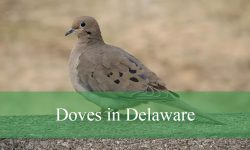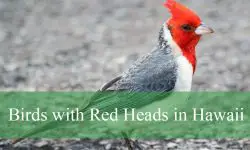Illinois’ woodlands, wetlands, and gardens are alive with the lively calls of wrens. Spotting these tiny, energetic birds is a delightful challenge for any nature enthusiast.
From hopping through backyard shrubs to weaving among cattails in marshes, each wren displays unique behaviors, songs, and charm. Observing them up close reveals their adaptability and playful energy.
Tracking all seven wren species in Illinois offers an immersive wildlife experience. With attention to habitat and song, birdwatchers can identify each species and enjoy a rewarding connection with nature.
Different Types of Wrens Found in Illinois
House Wren (Troglodytes aedon)
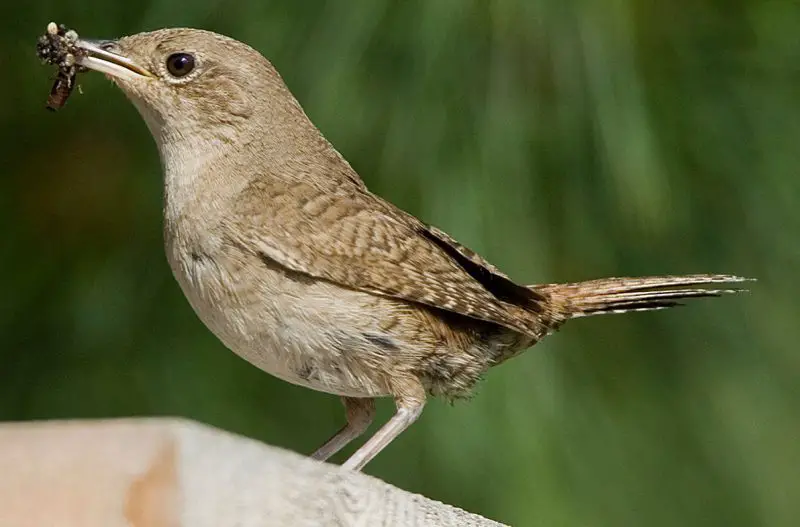
The House Wren is a small, energetic bird measuring about 4–5 inches (10–13 cm) in length with a wingspan of roughly 5–6 inches (13–15 cm). Its plumage is generally brown with subtle barring on the wings and tail, and a slightly paler underbelly. The bird has a short, slightly curved bill and bright, alert eyes, which give it a curious and lively expression. Males and females look very similar, though males often appear slightly more vibrant during the breeding season.
Identification of the House Wren is often aided by its distinctive, bubbly, and rapid song, which can last several seconds. It frequently perches on low shrubs, fence posts, or tree branches, and is known for its restless, hopping movement. Unlike some wrens that prefer dense cover, House Wrens are adaptable and often found near human habitation, including backyards and gardens. Their calls include a sharp “cheer” or “chuck” sound used to communicate with mates and rivals.
House Wrens are active foragers, feeding primarily on insects and spiders. They are known to investigate every nook and cranny, including old nest boxes, tree cavities, and brush piles. These birds are cavity nesters and do not build traditional nests; instead, they line small cavities with twigs and feathers. During the breeding season, males may fill multiple cavities with sticks to attract females, demonstrating their industrious and competitive behavior.
In Illinois, House Wrens are widespread during the breeding season, typically arriving in spring and leaving by late summer or early fall. They prefer open woodlands, gardens, farmlands, and suburban areas where shrubs and low trees provide nesting sites. Their adaptability to human-modified environments makes them one of the most commonly observed wrens in the state. Seasonal migration patterns take them to the southern United States, Mexico, and Central America for wintering, where they continue their insectivorous feeding habits.
Carolina Wren (Thryothorus ludovicianus)
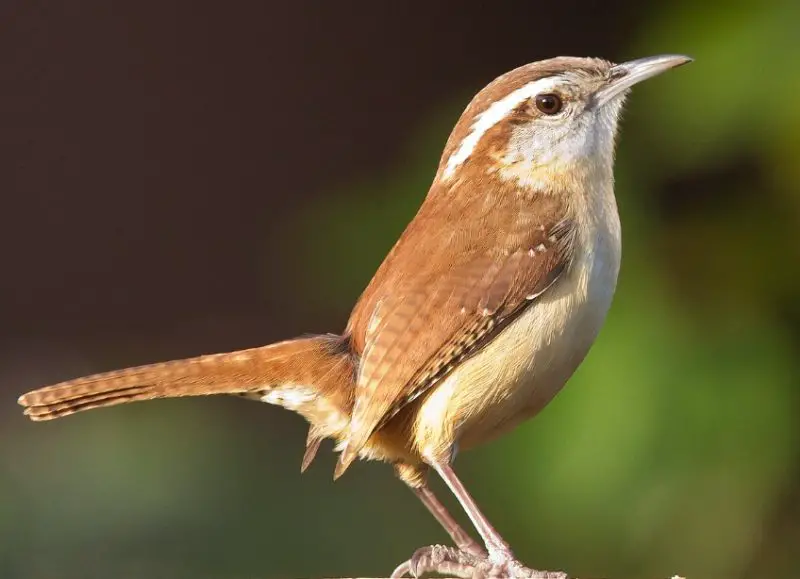
The Carolina Wren is a medium-sized wren, measuring about 5–6 inches (13–15 cm) in length with a wingspan of 8–10 inches (20–25 cm). It has rich reddish-brown upperparts, a warm buffy underbelly, and a prominent white eyebrow stripe that helps distinguish it from other wrens. Its slightly curved bill is long and strong, adapted for probing crevices for insects. Males and females are similar in appearance, though males may appear slightly larger.
Carolina Wrens are vocal birds, known for their loud, clear “teakettle-teakettle” song, which resonates throughout woodlands and gardens. They are active and curious, often moving in quick hops or short flights near the ground or low vegetation. Unlike more secretive wrens, they are bold around human habitation, frequently nesting in sheds, eaves, or dense shrubs.
These wrens are insectivorous, feeding on beetles, spiders, caterpillars, and occasionally seeds or fruit. They are cavity nesters, building domed nests in natural cavities, abandoned woodpecker holes, or artificial nest boxes. Both parents participate in feeding and caring for the young, and they may produce two to three broods per season, showing remarkable reproductive efficiency.
In Illinois, Carolina Wrens are resident birds, though populations are more concentrated in the southern and central parts of the state. They prefer dense thickets, forest edges, and suburban areas with adequate cover. Their numbers can fluctuate with harsh winters, but they are adaptable and increasingly observed in urban and rural environments alike.
Winter Wren (Troglodytes hiemalis)

The Winter Wren is a tiny, compact bird, about 3.5–4 inches (9–10 cm) long with a wingspan of 5–6 inches (13–15 cm). It has dark brown plumage with fine barring on the wings, tail, and flanks, along with a pale throat and slightly rounded tail. Its short, thin bill and small size give it an agile appearance, perfectly suited for navigating dense undergrowth. The Winter Wren’s short tail is often cocked upward, a characteristic behavior when alert or foraging.
Identification relies heavily on its rapid, complex, and musical song, which contrasts with its secretive behavior. Winter Wrens are extremely active, hopping and flitting through dense vegetation and leaf litter. They prefer dark, moist forests, often near streams or wetlands, and are usually difficult to spot due to their reclusive habits, making vocalizations the best indicator of their presence.
Winter Wrens primarily feed on insects, spiders, and other small invertebrates, foraging along the forest floor and in crevices. They are ground and low-vegetation nesters, building spherical nests with side entrances using moss, leaves, and feathers. Females lay several eggs per clutch, and both parents feed the hatchlings. These wrens demonstrate remarkable energy and persistence when gathering food.
In Illinois, Winter Wrens are seasonal migrants, mostly appearing during spring and fall migration in southern and central forests. They inhabit dense woodlands, ravines, and shaded wetlands, where thick understory provides both food and protection. Their small size and secretive nature make them a special find for birdwatchers in the state.
Bewick’s Wren (Thryomanes bewickii)
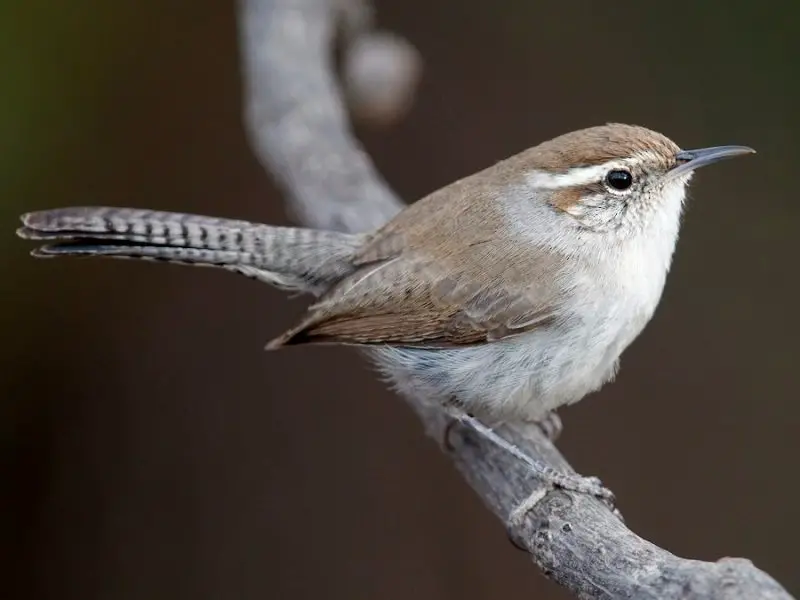
Bewick’s Wren is a slender wren, about 4–5 inches (10–12 cm) long with a wingspan of 6–7 inches (15–18 cm). It has gray-brown upperparts, a pale underbelly, and a distinctive long tail with white edges that it often flicks upward. A bold white eyebrow stripe runs above its eye, providing a clear identification marker. Its thin, slightly curved bill is adapted for probing insects in crevices and under bark.
This species is vocal and conspicuous, delivering a rich, varied song from exposed perches. Bewick’s Wrens are agile and curious, often exploring open brush, fence lines, and forest edges. They are less secretive than Winter Wrens but still prefer areas with ample cover for nesting and foraging.
Bewick’s Wrens feed mainly on insects, spiders, and other small invertebrates, foraging on the ground, in shrubs, and along tree trunks. They are cavity nesters, frequently using old woodpecker holes, crevices, or artificial nest boxes. The female lays several eggs per clutch, and both parents are involved in feeding. These birds are known for being territorial, especially during the breeding season.
In Illinois, Bewick’s Wrens are mostly observed in the western and southern parts of the state, favoring shrubby fields, woodland edges, and overgrown farmland. They prefer habitats that combine open areas with dense cover and are more likely to be seen during the warmer months when breeding and foraging actively.
Marsh Wren (Cistothorus palustris)
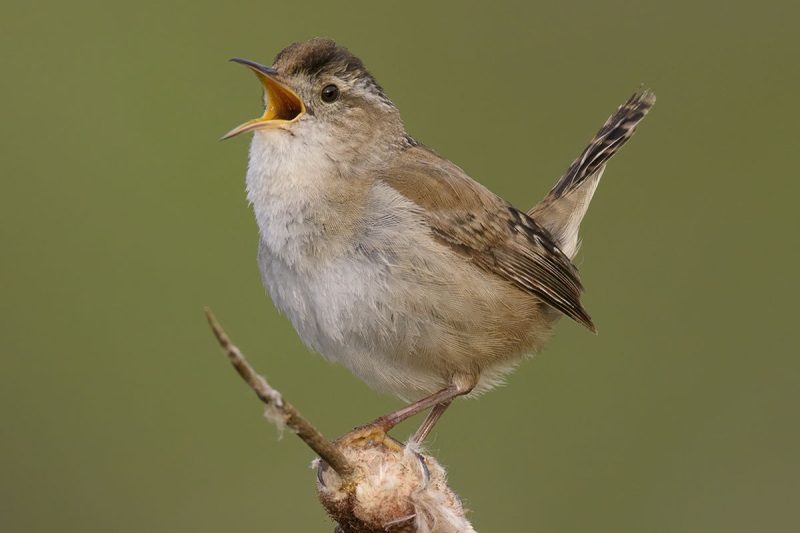
The Marsh Wren is a small wren, about 4–5 inches (10–13 cm) long with a wingspan of 6–7 inches (15–18 cm). Its upperparts are dark brown with bold black streaks, while the underparts are pale with a warm buff tone. A subtle white eyebrow stripe runs above the eye, and the tail is short and often held upright. The slender, slightly curved bill is well-adapted for probing marsh vegetation for insects.
Identification is aided by its complex, bubbly, and gurgling song, often performed from exposed reeds or cattails. Marsh Wrens are active and restless, hopping and flitting through dense marsh vegetation. They are secretive, usually staying close to the water’s edge, but can be detected by their loud vocalizations.
Marsh Wrens primarily feed on insects, spiders, and small aquatic invertebrates, often gleaned from reeds, cattails, and floating vegetation. They are cavity nesters but build elaborate spherical nests attached to reeds above water, sometimes with multiple “dummy” nests within a small territory. Females lay several eggs per clutch, and both parents help feed the young. These wrens are known for their territorial behavior, especially during breeding.
In Illinois, Marsh Wrens are summer residents, commonly found in freshwater marshes, wetlands, and pond edges throughout the state. They arrive in spring to breed and depart in late summer or early fall for southern wintering grounds. Their presence is closely tied to healthy wetland ecosystems, making them a favorite among birders visiting marsh habitats.
Sedge Wren (Cistothorus platensis)
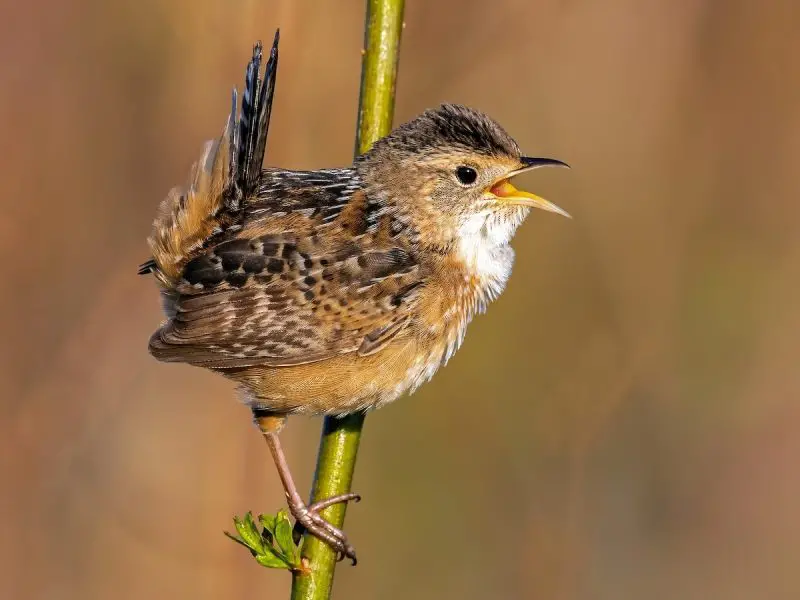
The Sedge Wren is a tiny, sparrow-sized wren, about 3.5–4.5 inches (9–11 cm) long with a wingspan of 5–6 inches (13–15 cm). It has brown upperparts with darker streaking and pale underparts. A faint eyebrow stripe is present, and the tail is short and often flicked upward. Its fine, slightly curved bill is ideal for probing dense sedges and grass for insects.
Sedge Wrens are vocal and energetic, producing a series of high-pitched trills and rattles. They are more secretive than other wrens, often hidden within tall grasses and sedges, making visual identification challenging. Birders usually rely on their distinctive songs to locate them.
Sedge Wrens feed mostly on insects and spiders, actively gleaning prey from grasses and marsh vegetation. They are ground and low-vegetation nesters, building small, dome-shaped nests close to the ground within dense sedges. Females lay several eggs per clutch, and both parents participate in feeding. These wrens are migratory, displaying energetic movements to forage and avoid predators.
In Illinois, Sedge Wrens are migratory summer visitors, often seen in wet meadows, prairies, and marsh edges during the breeding season. They are widely distributed but require tall, dense grasses for nesting. In fall, they migrate south to winter in the southern U.S. and Mexico.
Rock Wren (Salpinctes obsoletus)

The Rock Wren is a small to medium-sized wren, about 5–6 inches (12–15 cm) long with a wingspan of 7–8 inches (18–20 cm). Its plumage is gray-brown with fine streaking on the back and pale underparts. A subtle white eyebrow stripe and slightly longer tail distinguish it from other wrens. Its long, slightly curved bill is adapted for probing crevices among rocks and cliffs.
Rock Wrens are adapted to arid, rocky habitats, often seen hopping along rock ledges or cliff faces. They are not as vocal as some other wrens, producing a soft, musical trill that carries over short distances. Their behavior is characterized by careful exploration of rocky crevices for insects and spiders.
They feed primarily on insects, spiders, and small arthropods, actively searching in rock cracks and crevices. Rock Wrens are cavity nesters, often building nests in rock crevices, ledges, or abandoned burrows. Females lay a clutch of several eggs, and both parents share feeding duties. Their adaptation to rugged terrain helps reduce predation risks.
In Illinois, Rock Wrens are rare and mostly seen during migration in western parts of the state where rocky outcrops or quarries exist. They prefer dry, open, rocky habitats, making sightings uncommon and a special treat for birdwatchers.
Best Times and Locations to See Wrens in Illinois
Illinois offers a variety of habitats that support different wren species throughout the year. House Wrens are most commonly observed during the spring and summer breeding season, frequenting gardens, open woodlands, and suburban areas. They are adaptable and often nest in birdhouses, making them easy to spot in both rural and urban settings.
Carolina Wrens are resident birds, so they can be seen year-round, particularly in dense thickets, forest edges, and suburban backyards. They are more visible during the daytime when foraging or singing from exposed perches.
Winter Wrens are primarily migratory visitors, passing through Illinois in spring and fall. They prefer dense, moist forests, ravines, and shaded wetlands. Because of their secretive nature, birdwatchers often rely on their rapid, complex songs to locate them.
Bewick’s Wrens are more restricted in Illinois, usually appearing in southern and western parts of the state during warmer months. They inhabit shrubby fields, overgrown farmland, and forest edges, favoring areas with a mix of open spaces and dense cover.
Marsh Wrens are summer residents, frequenting freshwater marshes, ponds, and wetlands. Their distinctive bubbly songs make them easier to detect than to see, as they move actively through cattails and reeds.
Sedge Wrens are also migratory summer visitors, found in wet meadows, tallgrass prairies, and marsh edges. They rely on dense grasses and sedges for nesting, and their small size and secretive behavior make auditory cues essential for spotting them.
Rock Wrens are rare and mostly migratory, seen occasionally in western Illinois near quarries, rocky bluffs, or arid, open landscapes. Sightings are uncommon, so any observation is considered special for local birdwatchers.
FAQs About Wrens in Illinois
How many wren species are found in Illinois?
Illinois hosts 7 species of wrens, including House Wren, Carolina Wren, Winter Wren, Bewick’s Wren, Marsh Wren, Sedge Wren, and Rock Wren.
When is the best time to see wrens in Illinois?
Spring and summer are ideal for most wrens, especially for breeding species like House, Carolina, Marsh, and Sedge Wrens. Winter Wrens are best seen during migration in spring and fall, while Rock Wrens are rare and mostly observed during migration.
What habitats do wrens prefer in Illinois?
Wrens occupy a variety of habitats. House and Carolina Wrens prefer gardens, shrubs, and woodland edges. Marsh and Sedge Wrens thrive in wetlands and tallgrass prairies. Winter Wrens favor dense forests, and Rock Wrens inhabit rocky outcrops or open, arid areas.
Are any wrens in Illinois year-round residents?
Yes, Carolina Wrens are residents and can be seen throughout the year, though their visibility may decrease during harsh winters.
How can I identify different wrens by their song?
Each wren has a distinctive song. House Wrens have bubbly, rapid songs. Carolina Wrens deliver loud, clear “teakettle” phrases. Winter Wrens produce fast, complex trills, Marsh Wrens gurgling bubbly notes, and Sedge Wrens high-pitched rattles. Learning their calls is the easiest way to identify them in the field.




